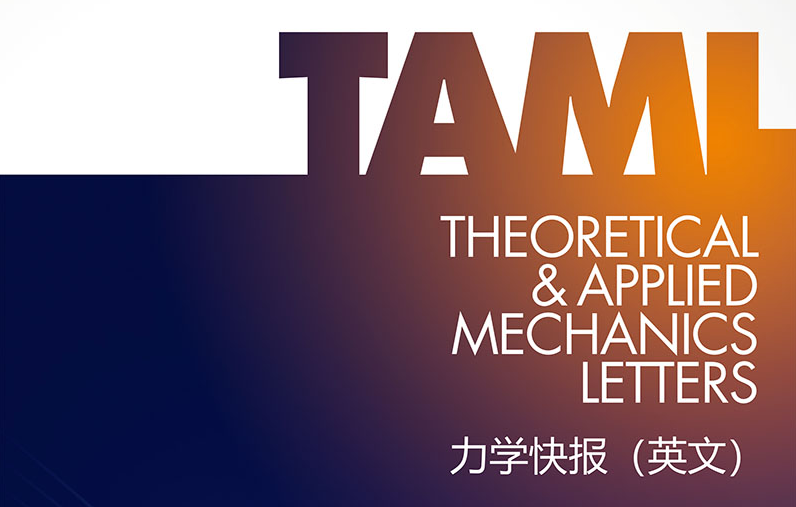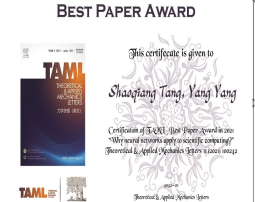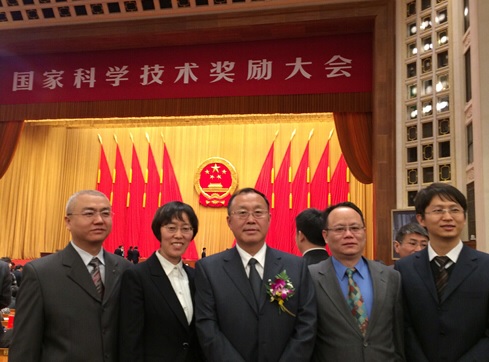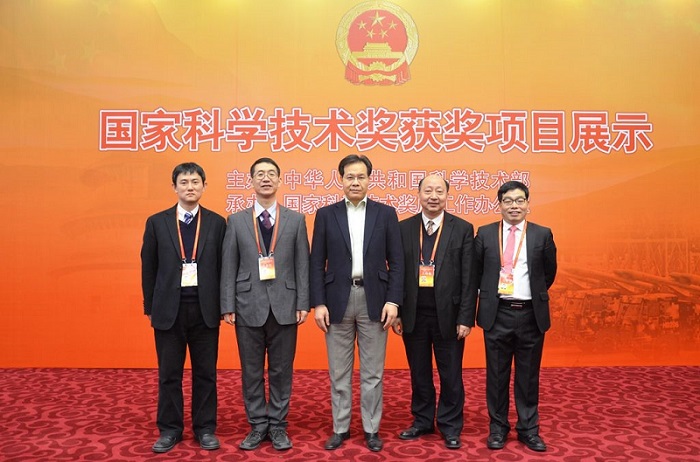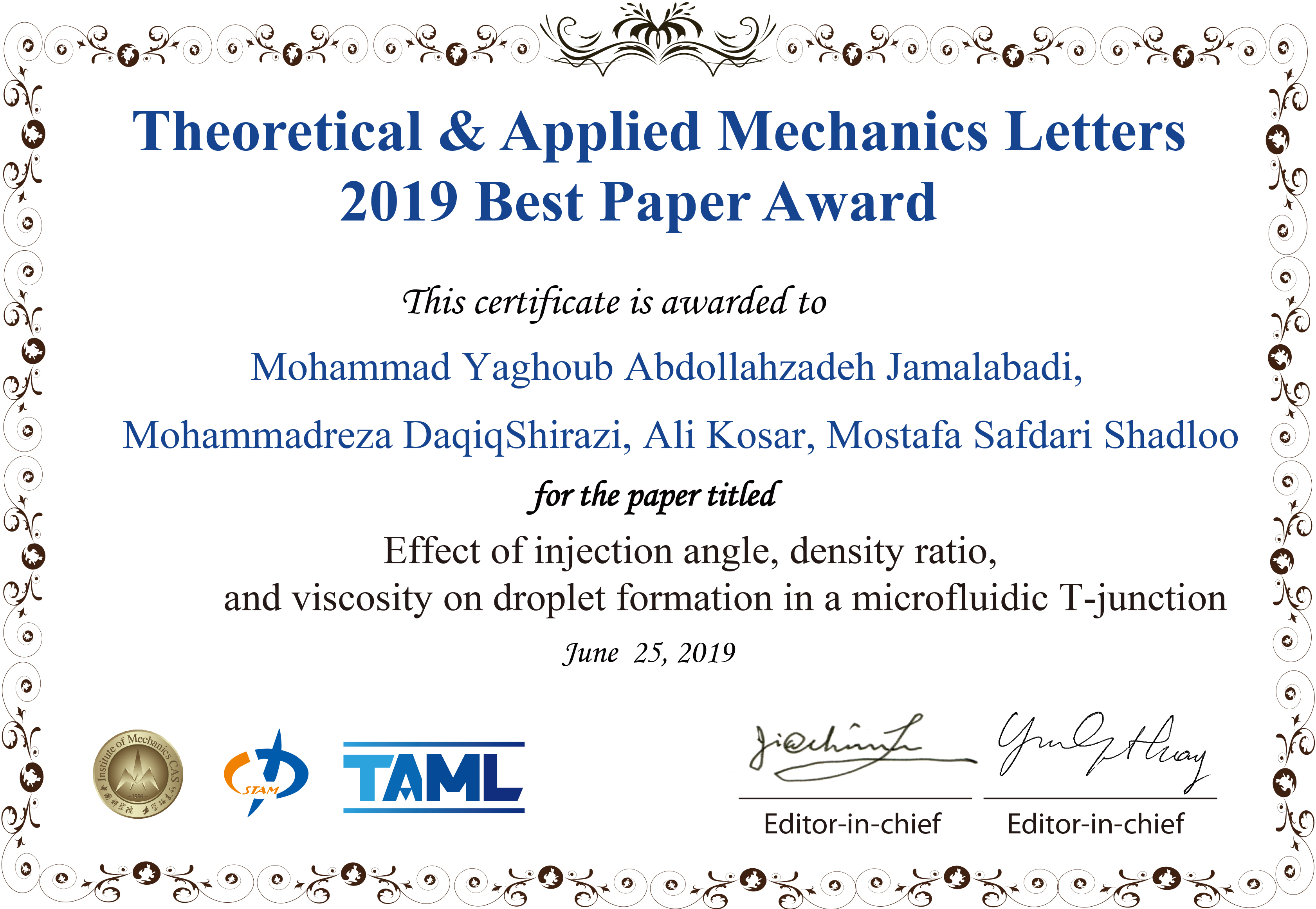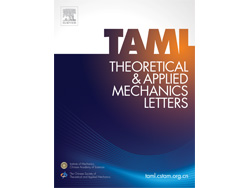Institute of Mechanics,
Chinese Academy of Sciences
2022 Vol.12(3)
Display Mode: |
Theoretical and Applied Mechanics Letters 12 (2022) 100306.
doi: 10.1016/j.taml.2021.100306
Abstract:
Based on strain-clustering via k-means, we decompose computational domain into clusters of possibly disjoint cells. Assuming cells in each cluster take the same strain, we reconstruct displacement field. We further propose a new way to condensate the governing equations of displacement-based finite element method to reduce the complexity while maintain the accuracy. Numerical examples are presented to illustrate the efficiency of the clustering solver. Numerical convergence studies are performed for the examples. Avoiding complexities which is common in existing clustering analysis methods, the proposed clustering solver is easy to implement, particularly for numerical homogenization using commercial softwares.
Based on strain-clustering via k-means, we decompose computational domain into clusters of possibly disjoint cells. Assuming cells in each cluster take the same strain, we reconstruct displacement field. We further propose a new way to condensate the governing equations of displacement-based finite element method to reduce the complexity while maintain the accuracy. Numerical examples are presented to illustrate the efficiency of the clustering solver. Numerical convergence studies are performed for the examples. Avoiding complexities which is common in existing clustering analysis methods, the proposed clustering solver is easy to implement, particularly for numerical homogenization using commercial softwares.
Theoretical and Applied Mechanics Letters 12 (2022) 100329.
doi: 10.1016/j.taml.2022.100329
Abstract:
Phase change materials are one of the potential resources to replace fossil fuels in regards of supplying the energy of buildings. Basically, these materials absorb or release heat energy with the help of their latent heat. Phase change materials have low thermal conductivity and this makes it possible to use the physical properties of these materials in the tropical regions where the solar radiation is more direct and concentrated over a smaller area. In this theoretical work, an attempt has been made to study the melting process of these materials by applying constant heat flux and temperature. It was found that by increasing the thickness of phase change materials' layers, due to the melting, more thermal energy is stored. Simultaneously it reduces the penetration of excessive heat into the chamber, so that by increasing the thickness of paraffin materials up to 20 mm, the rate of temperature reduction reaches more than 18%. It was also recognized that increasing the values of constant input heat flux increases buoyancy effects. Increasing the Stefan number from 0.1 to 0.3, increases the temperature by 6%.
Phase change materials are one of the potential resources to replace fossil fuels in regards of supplying the energy of buildings. Basically, these materials absorb or release heat energy with the help of their latent heat. Phase change materials have low thermal conductivity and this makes it possible to use the physical properties of these materials in the tropical regions where the solar radiation is more direct and concentrated over a smaller area. In this theoretical work, an attempt has been made to study the melting process of these materials by applying constant heat flux and temperature. It was found that by increasing the thickness of phase change materials' layers, due to the melting, more thermal energy is stored. Simultaneously it reduces the penetration of excessive heat into the chamber, so that by increasing the thickness of paraffin materials up to 20 mm, the rate of temperature reduction reaches more than 18%. It was also recognized that increasing the values of constant input heat flux increases buoyancy effects. Increasing the Stefan number from 0.1 to 0.3, increases the temperature by 6%.
Theoretical and Applied Mechanics Letters 12 (2022) 100333.
doi: 10.1016/j.taml.2022.100333
Abstract:
In this paper, the smoothed particle hydrodynamics (SPH) method is employed in modeling and numerical simulation of droplet coalescence. Considering the effect of tangential force on boundary material, besides normal force, tangential force is also introduced in the continuum surface force (CSF) model. The formation of droplet, the coalescence processes of two droplets and three droplets are simulated by the modified CSF model. The validity of the modified model is verified from the aspects of the morphological change of the droplet, the smoothness of free surface and the conservation of the centroid of the system. Compared with finite element method, the results of the modified CSF model show that tangential force plays a crucial role in the CSF model when dealing with model boundary with curves and sharp angles.
In this paper, the smoothed particle hydrodynamics (SPH) method is employed in modeling and numerical simulation of droplet coalescence. Considering the effect of tangential force on boundary material, besides normal force, tangential force is also introduced in the continuum surface force (CSF) model. The formation of droplet, the coalescence processes of two droplets and three droplets are simulated by the modified CSF model. The validity of the modified model is verified from the aspects of the morphological change of the droplet, the smoothness of free surface and the conservation of the centroid of the system. Compared with finite element method, the results of the modified CSF model show that tangential force plays a crucial role in the CSF model when dealing with model boundary with curves and sharp angles.
Theoretical and Applied Mechanics Letters 12 (2022) 100338.
doi: 10.1016/j.taml.2022.100338
Abstract:
The exact similarity solutions of two dimensional laminar boundary layer were obtained by Blasius in 1908, however, for two dimensional turbulent boundary layers, no Blasius type similarity solutions (special exact solutions) have ever been found. In the light of Blasius' pioneer works, we extend Blasius similarity transformation to the two dimensional turbulent boundary layers, and for a special case of flow modelled by Prandtl mixing-length, we successfully transform the two dimensional turbulent boundary layers partial differential equations into a single ordinary differential equation. The ordinary differential equation is numerically solved and some useful quantities are produced. For numerical calculations, a complete Maple code is provided.
The exact similarity solutions of two dimensional laminar boundary layer were obtained by Blasius in 1908, however, for two dimensional turbulent boundary layers, no Blasius type similarity solutions (special exact solutions) have ever been found. In the light of Blasius' pioneer works, we extend Blasius similarity transformation to the two dimensional turbulent boundary layers, and for a special case of flow modelled by Prandtl mixing-length, we successfully transform the two dimensional turbulent boundary layers partial differential equations into a single ordinary differential equation. The ordinary differential equation is numerically solved and some useful quantities are produced. For numerical calculations, a complete Maple code is provided.
Theoretical and Applied Mechanics Letters 12 (2022) 100341.
doi: 10.1016/j.taml.2022.100341
Abstract:
Flexible piezoelectric energy harvesters (PEHs) have gained lots of attention in recent years, because of their potential biomechanical applications, such as powering implantable devices. Several in vivo animal experiments have demonstrated that the output power of a flexible PEH varies remarkably with patching orientations and locations, but the underlying mechanism remains unclear yet. Herein, an electromechanical model for a flexible PEH installed on a beating heart is proposed, and a concise relationship between the output power of the device and myocardium strain is established. The results demonstrate that the patching orientations have a significant impact on the output power of the PEH, and the optimal patching orientations for all patching locations are approximately 15-20 degree for PEHs mounted on the left ventricle. The simple theoretical method provided here would be universally effective for choosing the optimal patching locations and orientations of flexible PEHs installed on a nonhomogeneous deformed surface.
Flexible piezoelectric energy harvesters (PEHs) have gained lots of attention in recent years, because of their potential biomechanical applications, such as powering implantable devices. Several in vivo animal experiments have demonstrated that the output power of a flexible PEH varies remarkably with patching orientations and locations, but the underlying mechanism remains unclear yet. Herein, an electromechanical model for a flexible PEH installed on a beating heart is proposed, and a concise relationship between the output power of the device and myocardium strain is established. The results demonstrate that the patching orientations have a significant impact on the output power of the PEH, and the optimal patching orientations for all patching locations are approximately 15-20 degree for PEHs mounted on the left ventricle. The simple theoretical method provided here would be universally effective for choosing the optimal patching locations and orientations of flexible PEHs installed on a nonhomogeneous deformed surface.
Theoretical and Applied Mechanics Letters 12 (2022) 100342.
doi: 10.1016/j.taml.2022.100342
Abstract:
The study of the natural convective flow of a fluid in the presence of an induced magnetic field has always been of considerable importance due to its many applications in various areas of science, technology, and industry, such as the operation of magnetohydrodynamic generators. This study addresses an analysis of exponential heat source and induced magnetic field on the second-class convection of Casson fluid in a microchannel. The flow is in a vertical microchannel organized by two vertical plates. The answer to governing equations has been grabbed for temperature field, induced magnetic field, and velocity via Akbari-Ganji's method (AGM). Nusselt number, skin friction coefficient, and current density are approximated. Graphs that describe the conclusion of influential physical variables on velocity, temperature, current density, induced magnetic field, and skin friction coefficient distributions are shown. Comparison of results with numerical method (Runge-Kutta-Fehlberg, RKF-45), homotopy perturbation method, and AGM confirms the accuracy of answers obtained with AGM.
The study of the natural convective flow of a fluid in the presence of an induced magnetic field has always been of considerable importance due to its many applications in various areas of science, technology, and industry, such as the operation of magnetohydrodynamic generators. This study addresses an analysis of exponential heat source and induced magnetic field on the second-class convection of Casson fluid in a microchannel. The flow is in a vertical microchannel organized by two vertical plates. The answer to governing equations has been grabbed for temperature field, induced magnetic field, and velocity via Akbari-Ganji's method (AGM). Nusselt number, skin friction coefficient, and current density are approximated. Graphs that describe the conclusion of influential physical variables on velocity, temperature, current density, induced magnetic field, and skin friction coefficient distributions are shown. Comparison of results with numerical method (Runge-Kutta-Fehlberg, RKF-45), homotopy perturbation method, and AGM confirms the accuracy of answers obtained with AGM.
Theoretical and Applied Mechanics Letters 12 (2022) 100343.
doi: 10.1016/j.taml.2022.100343
Abstract:
Anisotropic plates in different applications may have geometric defects such as openings and cracks. The presence of the opening disturbs the heat flow, which creates significant thermal stress around the opening. When the heat flux is high enough, these extreme stresses can lead to structural failure. This article aims to obtain the optimal parameters for achieving the minimum value of the normalized stress near the cutout's boundary in perforated anisotropic plates utilizing the genetic algorithm. Optimization parameters include the curvature of opening's corners, orientation angle of opening, fibers angle, heat flux angle, and opening's elongation. The plate is under heat flux, and the opening's border is thermally insulated. The stress distribution around the opening is calculated using Lekhnitskii's complex variable method and complex potential functions. The genetic algorithm is then implemented to find the optimal values for design parameters. The results show that by selecting the optimal parameters related to the anisotropic material and the opening's geometry, the stress intensity factor of the perforated anisotropic plates is remarkably reduced. Furthermore, this optimization algorithm can be extended to find the optimized parameters and achieve the optimal designs in anisotropic and isotropic perforated plates under thermal loadings.
Anisotropic plates in different applications may have geometric defects such as openings and cracks. The presence of the opening disturbs the heat flow, which creates significant thermal stress around the opening. When the heat flux is high enough, these extreme stresses can lead to structural failure. This article aims to obtain the optimal parameters for achieving the minimum value of the normalized stress near the cutout's boundary in perforated anisotropic plates utilizing the genetic algorithm. Optimization parameters include the curvature of opening's corners, orientation angle of opening, fibers angle, heat flux angle, and opening's elongation. The plate is under heat flux, and the opening's border is thermally insulated. The stress distribution around the opening is calculated using Lekhnitskii's complex variable method and complex potential functions. The genetic algorithm is then implemented to find the optimal values for design parameters. The results show that by selecting the optimal parameters related to the anisotropic material and the opening's geometry, the stress intensity factor of the perforated anisotropic plates is remarkably reduced. Furthermore, this optimization algorithm can be extended to find the optimized parameters and achieve the optimal designs in anisotropic and isotropic perforated plates under thermal loadings.
Theoretical and Applied Mechanics Letters 12 (2022) 100344.
doi: 10.1016/j.taml.2022.100344
Abstract:
Decelerating open-channel flow is a type of flow that gradually moves forward with decreasing velocity and increasing water depth. Although all flow parameters change along the streamwise direction, previous studies have revealed that these parameters' vertical distributions at different sections can be universally described with a single profile when being nondimensionalised by appropriate scales. This study focuses on the population trends of spanwise rotational motions at various sections along the main flow direction by particle imaging velocimetry (PIV) measurement. The wall-normal population distributions of density, radius, swirling strength, and convection velocity of the prograde and retrograde motions show similar trends in uniform open-channel flows. The dimensionless representation is invariant along the main flow direction. This study's results indicate the self-similar characteristic of population trends of spanwise rotational motions prevails in decelerating open-channel flow.
Decelerating open-channel flow is a type of flow that gradually moves forward with decreasing velocity and increasing water depth. Although all flow parameters change along the streamwise direction, previous studies have revealed that these parameters' vertical distributions at different sections can be universally described with a single profile when being nondimensionalised by appropriate scales. This study focuses on the population trends of spanwise rotational motions at various sections along the main flow direction by particle imaging velocimetry (PIV) measurement. The wall-normal population distributions of density, radius, swirling strength, and convection velocity of the prograde and retrograde motions show similar trends in uniform open-channel flows. The dimensionless representation is invariant along the main flow direction. This study's results indicate the self-similar characteristic of population trends of spanwise rotational motions prevails in decelerating open-channel flow.
Theoretical and Applied Mechanics Letters 12 (2022) 100345.
doi: 10.1016/j.taml.2022.100345
Abstract:
The hot-section parts easily occur the creep-fatigued interaction under the condition of mechanicalthermal coupled load during the period of service, which may lead to the damage of the parts, and therefore, the measurement and characterization of thermal-deformed fields of the parts are important to understand its damage process. Aiming at relevant demand, the bilateral telecentric-multispectral imaging system was established, the research of synchronous measurement technique of the temperature and deformation fields was developed. On the one hand, the measurement technology for surface temperature of the object was developed using the two-color images captured by the multispectral camera with bilateral telecentric lens and combined with colorimetric method. On the other hand, the 2D-DIC measurement technique of the multispectral camera was developed by conducting digital image correlation analysis using the blue light images before and after deformation, which can measure the high temperature deformation field of the object (the blue light images were filtered by multispectral camera). Results showed that the bilateral telecentric lens is used to replace the ordinary optical lens for imaging, which can effectively eliminate the distortion of the multispectral imaging system. Since the temperature measurement process of this measurement system is little affected by the emissivity of the object, therefore, it has excellent robustness. The thermal expansion coefficients of the nickel alloys are evaluated at the temperature ranges of 700-1000 ℃, indicating this system can achieve the synchronous and precise measurement of the temperature and deformation fields of the object.
The hot-section parts easily occur the creep-fatigued interaction under the condition of mechanicalthermal coupled load during the period of service, which may lead to the damage of the parts, and therefore, the measurement and characterization of thermal-deformed fields of the parts are important to understand its damage process. Aiming at relevant demand, the bilateral telecentric-multispectral imaging system was established, the research of synchronous measurement technique of the temperature and deformation fields was developed. On the one hand, the measurement technology for surface temperature of the object was developed using the two-color images captured by the multispectral camera with bilateral telecentric lens and combined with colorimetric method. On the other hand, the 2D-DIC measurement technique of the multispectral camera was developed by conducting digital image correlation analysis using the blue light images before and after deformation, which can measure the high temperature deformation field of the object (the blue light images were filtered by multispectral camera). Results showed that the bilateral telecentric lens is used to replace the ordinary optical lens for imaging, which can effectively eliminate the distortion of the multispectral imaging system. Since the temperature measurement process of this measurement system is little affected by the emissivity of the object, therefore, it has excellent robustness. The thermal expansion coefficients of the nickel alloys are evaluated at the temperature ranges of 700-1000 ℃, indicating this system can achieve the synchronous and precise measurement of the temperature and deformation fields of the object.
Theoretical and Applied Mechanics Letters 12 (2022) 100348.
doi: 10.1016/j.taml.2022.100348
Abstract:
Present study provides a simple analytical formula, the "Klingel-like formula" or "Pascal's Formula" that can be used as a reference to test some results of existing railway codes and specifically those using rigid contact. It develops properly the 3D Newton-Euler equations governing the 6 degrees of freedom (DoF) of unsuspended loaded wheelsets in case of zero wheel-rail friction and constant conicity. Thus, by solving numerically these equations, we got pendulum like harmonic oscillations of which the calculated angular frequency is used for assessing the accuracy of the proposed formula so that it can in turn be used as a fast practical target for testing multi-body system (MBS) railway codes. Due to the harmonic property of these pendulum-like oscillations, the square ω2 of their angular frequency can be made in the form of a ratio K/M where K depends on the wheelset geometry and load and M on its inertia. Information on K and M are useful to understand wheelsets behavior. The analytical formula is derived from the first order writing of full trigonometric Newton-Euler equations by setting zero elastic wheel-rail penetration and by assuming small displacements. Full trigonometric equations are numerically solved to assess that the formula provides ω2 inside a 1% accuracy for usual wheelsets dimensions. By decreasing the conicity down to 1×10-4 rad, the relative formula accuracy is under 3×10-5. In order to test the formula reliability for rigid contact formulations, the stiffness of elastic contacts can be increased up to practical rigidity (Hertz stiffness×1000).
Present study provides a simple analytical formula, the "Klingel-like formula" or "Pascal's Formula" that can be used as a reference to test some results of existing railway codes and specifically those using rigid contact. It develops properly the 3D Newton-Euler equations governing the 6 degrees of freedom (DoF) of unsuspended loaded wheelsets in case of zero wheel-rail friction and constant conicity. Thus, by solving numerically these equations, we got pendulum like harmonic oscillations of which the calculated angular frequency is used for assessing the accuracy of the proposed formula so that it can in turn be used as a fast practical target for testing multi-body system (MBS) railway codes. Due to the harmonic property of these pendulum-like oscillations, the square ω2 of their angular frequency can be made in the form of a ratio K/M where K depends on the wheelset geometry and load and M on its inertia. Information on K and M are useful to understand wheelsets behavior. The analytical formula is derived from the first order writing of full trigonometric Newton-Euler equations by setting zero elastic wheel-rail penetration and by assuming small displacements. Full trigonometric equations are numerically solved to assess that the formula provides ω2 inside a 1% accuracy for usual wheelsets dimensions. By decreasing the conicity down to 1×10-4 rad, the relative formula accuracy is under 3×10-5. In order to test the formula reliability for rigid contact formulations, the stiffness of elastic contacts can be increased up to practical rigidity (Hertz stiffness×1000).
 Submit a Paper
Submit a Paper
 Subscription
Subscription
News
MORE+
Call for Papers
MORE+
- Crossing-Mechanics Driven by Big Data
- Machine learning in the fluid mechanics research of wind energy
- Mechanics of Origami/Kirigami structures and metamaterials
- New insights and perspectives on impact biomechanics for human tissues: from injury prevention, protection to protective equipment
- Environmental Mechanics for Extreme Natural Events





